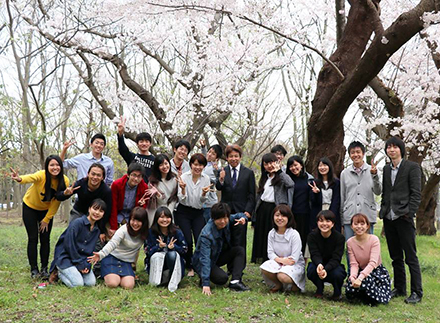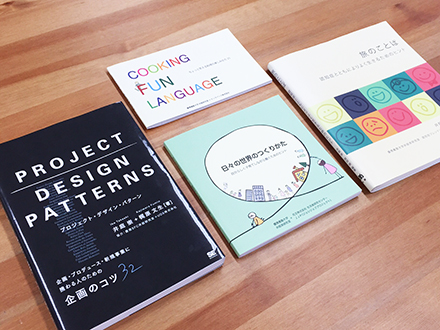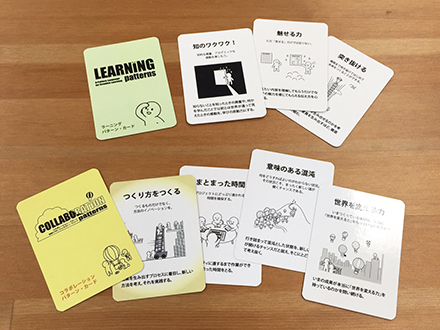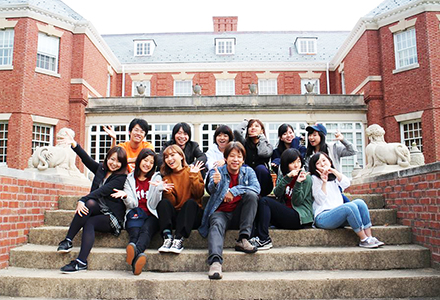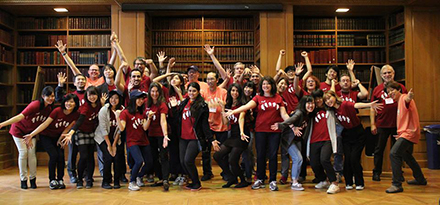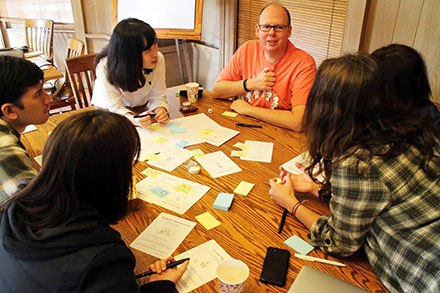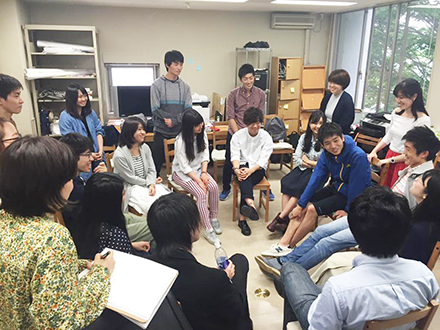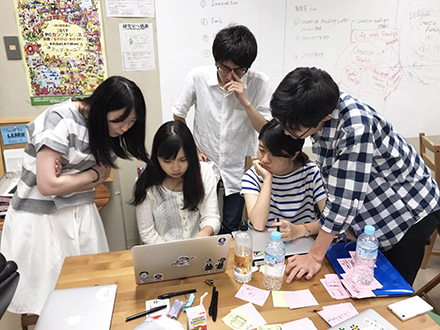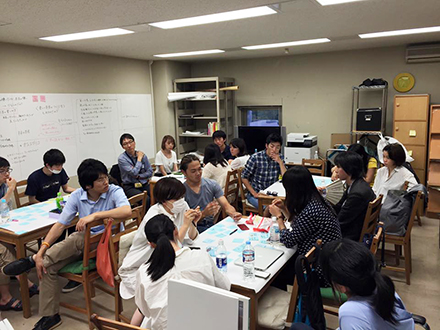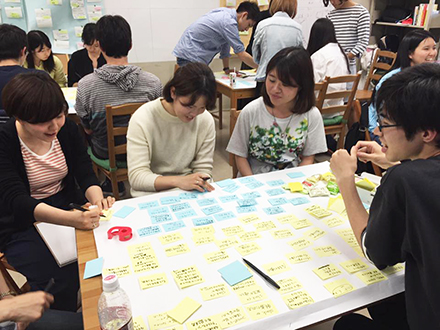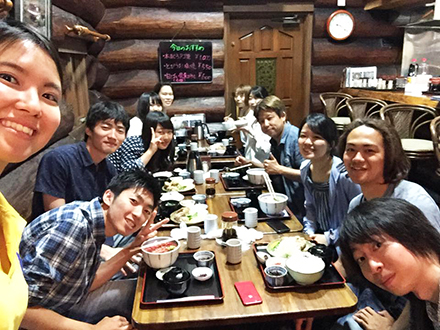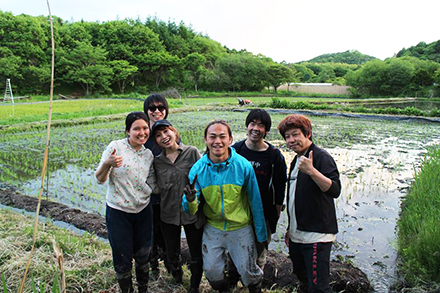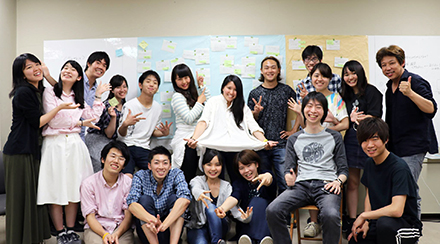New Members Wanted! Iba Lab B (GIGA), 2017 Fall
Iba Lab B (GIGA) Syllabus
Natural & Creative Living Lab: Global Collaboration to Empower People with Pattern Languages
(Tuesday 5th period, 2017 Fall semester)
Entry submission deadline: July 19th
Interview Session: July 26th or 27th
Purpose
Our society is becoming more complex and diverse day by day. Finding a way to design the future with our own hands has become a fundamental problem for us today. To be creative in such a society, we must create our own visions, and design tools and methods to make our visions a reality.
In our lab, we define a “Creative Society” as a society where people create their own goods, tools, concepts, knowledge, mechanisms, and ultimately the future with their own hands. Creation in this society is no longer limited to just companies and organizations, but is entrusted to each and every individual.
In such a creative society, pattern languages are key media for supporting creative acts. A Pattern Language is a collection of information called “patterns,” which together works in a language-like structure to scribe out the practical knowledge related to a certain field of knowledge.
The mission of our lab is to create human action pattern languages in various languages, and present / spread them all over the world, and engage in global collaboration to empower people with them. In order to achieve this, our lab conducts primarily three types of research:
1. Creating new pattern languages from scratch. - The team will go through all of the process of creating a pattern language in English. The aim will be to create a pattern language that can be shared internationally. The themes of pattern languages will be related to ways of natural and creative living or how to shift our society to be more natural and creative.
2. Translate pattern languages into other languages (publishing level). - The team will translate a pattern language (created in the Iba lab) into another language (precedents include: English, Korean, German, Malay, etc.) at a level that can be published as book and shared internationally.
3. Explore new ways of expressing patterns. - The team will propose and design a new form of expression to share pattern languages. For the past forty years, pattern languages have been shared as reading materials, most commonly as printed books and papers, and recently as cards to be used in interactive workshops. Recently, we created Pattern Objects, which are objects that express patterns to help us recall the right pattern for the right situation, and Pattern Song, where patterns are embedded in lyrics of the song.
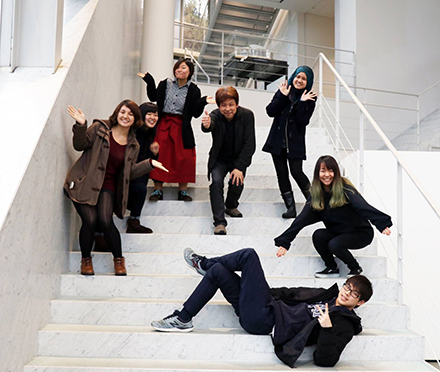
Number of Students
10
Requirement
The theme for our lab is creativity. We are looking for prospective lab members who are willing to commit creatively to the future!
Class Schedule
Official meeting will be on 5th period of Tuesday.
We will sometimes go dinner together after the meeting.
Members are required to work on their projects outside of class time.
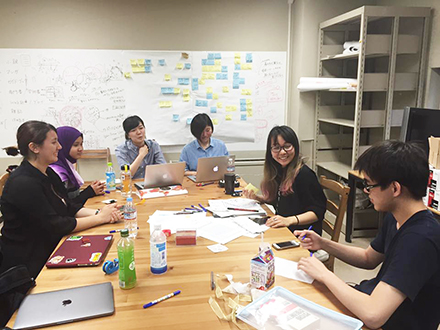
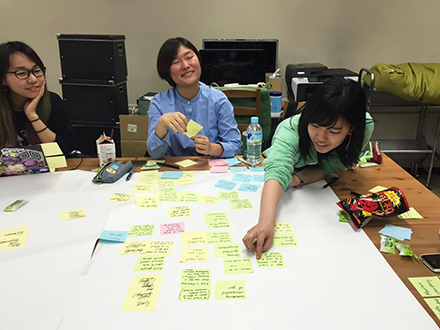
Special Note
With regards to the timing of enrollment, we highly encourage students to join during their early years at SFC (1st years and 2nd years are welcome). Joining early will allow students to gain research experience and get more opportunities.
We are looking for members who are willing to study together with us in a long perspective. Breakthrough in knowledge and skills can be expected through long-term commitment.
Join us on opportunities to go on overseas trips to attend workshops and academic conferences. This year we will be visiting the US in September, Austria & Canada in October.
Screening Schedule
Entry submission deadline: July 19th
Interview Session: July 26th or 27th
Assignment
After reading through this syllabus thoroughly, please submit the entry assignment described below via email by July 19th.
Email to: ilab-entry [at] sfc.keio.ac.jp
Subject: Iba Lab B (2017 Fall) Entry
Please attach your entry assignment in a Word, Pages or PDF file.
Iba Lab B (2017 Fall) Entry
1. Name, Faculty, Grade, Student ID, login ID
2. Profile photo (for reference to interview session)
3. Topic of study you wish to work on in the lab. Reason for your entry. Your enthusiasm towards the project.
4. Other Labs you are planning on joining next semester (if any)
5. Labs you have been a part of (if any)
6. Favorite classes you've taken so far (Multiple answers are welcome)
7. Courses by Prof. Iba which you have taken before (if any)
8. Any other introduction of yourself. (Circles, activities, interests, future visions, any other points to sell) *
* You are welcome to use any pictures or diagrams.
The selection interview will be held based on the information given in the entry assignment.
Assesment Method
Grading will be based on participation, presentation, and project.
Materials & Reading List
References
Important Introductory Papers from Iba Lab
Iba Lab Patterns
Pattern Language Studies and Examples in Various Areas
Creativity, Collaboration, and Creative Society
Related Courses
PATTERN LANGUAGE (GIGA)
Contact
ilab-entry [at] sfc.keio.ac.jp
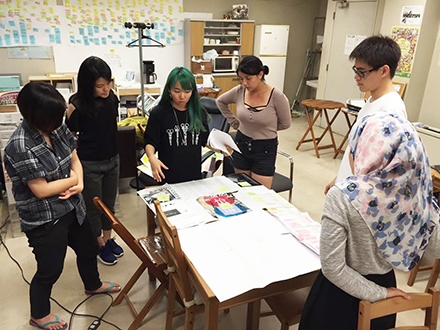
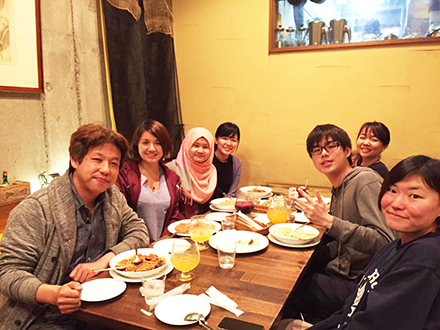
Iba Lab B (GIGA) - Natural & Creative Living Lab: Global Collaboration to Empower People with Pattern Languages
Natural & Creative Living Lab: Global Collaboration to Empower People with Pattern Languages
(Tuesday 5th period, 2017 Fall semester)
Purpose
Our society is becoming more complex and diverse day by day. Finding a way to design the future with our own hands has become a fundamental problem for us today. To be creative in such a society, we must create our own visions, and design tools and methods to make our visions a reality.
In our lab, we define a “Creative Society” as a society where people create their own goods, tools, concepts, knowledge, mechanisms, and ultimately the future with their own hands. Creation in this society is no longer limited to just companies and organizations, but is entrusted to each and every individual.
In such a creative society, pattern languages are key media for supporting creative acts. A Pattern Language is a collection of information called “patterns,” which together works in a language-like structure to scribe out the practical knowledge related to a certain field of knowledge.
The mission of our lab is to create human action pattern languages in various languages, and present / spread them all over the world, and engage in global collaboration to empower people with them. In order to achieve this, our lab conducts primarily three types of research:
1. Creating new pattern languages from scratch. - The team will go through all of the process of creating a pattern language in English. The aim will be to create a pattern language that can be shared internationally. The themes of pattern languages will be related to ways of natural and creative living or how to shift our society to be more natural and creative.
2. Translate pattern languages into other languages (publishing level). - The team will translate a pattern language (created in the Iba lab) into another language (precedents include: English, Korean, German, Malay, etc.) at a level that can be published as book and shared internationally.
3. Explore new ways of expressing patterns. - The team will propose and design a new form of expression to share pattern languages. For the past forty years, pattern languages have been shared as reading materials, most commonly as printed books and papers, and recently as cards to be used in interactive workshops. Recently, we created Pattern Objects, which are objects that express patterns to help us recall the right pattern for the right situation, and Pattern Song, where patterns are embedded in lyrics of the song.

Number of Students
10
Requirement
The theme for our lab is creativity. We are looking for prospective lab members who are willing to commit creatively to the future!
Class Schedule


Special Note
Screening Schedule
Assignment
After reading through this syllabus thoroughly, please submit the entry assignment described below via email by July 19th.
Email to: ilab-entry [at] sfc.keio.ac.jp
Subject: Iba Lab B (2017 Fall) Entry
Please attach your entry assignment in a Word, Pages or PDF file.
Iba Lab B (2017 Fall) Entry
1. Name, Faculty, Grade, Student ID, login ID
2. Profile photo (for reference to interview session)
3. Topic of study you wish to work on in the lab. Reason for your entry. Your enthusiasm towards the project.
4. Other Labs you are planning on joining next semester (if any)
5. Labs you have been a part of (if any)
6. Favorite classes you've taken so far (Multiple answers are welcome)
7. Courses by Prof. Iba which you have taken before (if any)
8. Any other introduction of yourself. (Circles, activities, interests, future visions, any other points to sell) *
* You are welcome to use any pictures or diagrams.
The selection interview will be held based on the information given in the entry assignment.
Assesment Method
Grading will be based on participation, presentation, and project.
Materials & Reading List
References
- Takashi Iba, “Pattern Language 3.0 and Fundamental Behavioral Properties,” in Pursuit of Pattern Languages for Societal Change. Designing Lively Scenarios in Various Fields, eds by Peter Baumgartner, Tina Gruber-Muecke, Richard Sickinger, Berlin: epubli, 2016, pp.200-233 [ Book PDF ]
- Takashi Iba, “Pattern Languages as Media for Creative Dialogue: Functional Analysis of Dialogue Workshops” in PURPLSOC: The Workshop 2014, eds by Peter Baumgartner, Richard Sickinger, Berlin: epubli, 2015, pp.236-255 [ Book PDF ]
- Takashi Iba, “Future Language for Collaborative Design,” PUARL Conference 2016, USA, Oct., 2016 [ Paper PDF ]
- Takashi Iba, Taichi Isaku, “Creating a Pattern Language for Creating Pattern Languages: 364 Patterns for Pattern Mining, Writing, and Symbolizing,” 23rd Conference on Pattern Languages of Programs (PLoP2016), USA, Oct., 2016 [ Paper PDF ]
- Takashi Iba, “An Autopoietic Systems Theory for Creativity,” Procedia - Social and Behavioral Sciences, Vol.2, Issue 4, 2010, pp.305–6625. [ Paper PDF ]
- Takashi Iba with Iba Lab, Learning Patterns: A Pattern Language for Creative Learning, CreativeShift Lab, 2014
- Takashi Iba with Iba Lab, Presentation Patterns: A Pattern Language for Creative Presentations, CreativeShift Lab, 2014
- Takashi Iba with Iba Lab, Collaboration Patterns: A Pattern Language for Creative Collaborations, CreativeShift Lab, 2014
- Takashi Iba & Makoto Okada (eds), Iba Lab., and DFJI (Dementia Friendly Japan Initiative), Words for a Journey: The Art of Being with Dementia, CreativeShift Lab, 2015
- Tomoki Furukawazono & Takashi Iba, Survival Language Project, Survival Language: A Pattern Language for Surviving Earthquakes, CreativeShift Lab, 2015
- Eri Shimomukai & Sumire Nakamura with Takashi Iba, Change Making Patterns: A Pattern Language for Fostering Social Entrepreneurship, CreativeShift Lab, 2015
- Kaori Harasawa, Natsumi Miyazaki, Rika Sakuraba, & Takashi Iba, A Tale of Pattern Illustrating, CreativeShift Lab, 2015
- Takashi Iba with Iba Lab, Pattern Illustrating Patterns: A Pattern Language for Pattern Illustrating, CreativeShift Lab, 2015
- Tetsuro Kubota, Yuji Harashima, Haruka Mori, Tsuyoshi Ishida, Kaori Harasawa, and Takashi Iba, “Project Design Patterns: Patterns for Designing Architectural Projects,” 5th Asian Conference on Pattern Languages of Programs (AsianPLoP2016), Taiwan, Mar., 2016 [ Paper PDF ]
- Haruka Mori, Yuji Harashima, Tsuyoshi Ishida, Ayaka Yoshikawa, Takashi Iba, “Project Design Patterns: Sharing the Practices in Successful Projects,” PUARL Conference 2016, USA, Oct., 2016 [ Paper PDF ]
- Yuma Akado, Shiori Shibata, Ayaka Yoshikawa, Akimitsu Sano, and Takashi Iba, “Cooking Patterns: A Pattern Language for Everyday Cooking,” 5th Asian Conference on Pattern Languages of Programs (AsianPLoP2016), Taiwan, Mar., 2016 [ Paper PDF ]
- Alice Sasabe, Taichi Isaku, Tomoki Kaneko, Emi Kubonaga, and Takashi Iba, “Parenting Patterns: A Pattern Language for Growing with your Child,” 5th Asian Conference on Pattern Languages of Programs (AsianPLoP2016), Taiwan, Mar., 2016 [ Paper PDF ]
- Arisa Kamada, Rina Kato, Yuma Akado, Takashi Iba, “Natural Living Patterns: A Pattern Language for Ethical and Sustainable Life,” 23rd Conference on Pattern Languages of Programs (PLoP2016) USA, Oct., 2016 [ Paper PDF ]
- Takashi Iba, Aya Matsumoto, Arisa Kamada, Nao Tamaki, and Tomoki Kaneko, “A Pattern Language for Living Well with Dementia: Words for a Journey,” International Journal of Organisational Design and Engineering, Volume 4, No. 1/2, 2016, pp.85-112
- Christopher Alexander, The Timeless Way of Building, Oxford University Press, 1979
- Christopher Alexander, Sara Ishikawa, and Murray Silverstein, A Pattern Language: Towns, Buildings, Construction, Oxford University Press, 1977
- Christopher Alexander, Murray Silverstein, Shlomo Angel, Sara Ishikawa, Denny Abrams, The Oregon Experiment, Oxford University Press, 1975
- Christopher Alexander with Howard Davis, Julio Martinez, Don Corner, The Production of Houses, Oxford University Press, 1985
- Christopher Alexander, The Nature of Order, BOOK ONE: The Phenomenon of Life, The Center for Environmental Structure, 2002
- Christopher Alexander, The Nature of Order, Book 2: The Process of Creating Life, The Center for Environmental Structure, 2003
- Mary Lynn Manns, Linda Rising, More Fearless Change: Strategies for Making Your Ideas Happen, Addison-Wesley Professional, 2015
- James O. Coplien, Neil B. Harrison, Organizational Patterns of Agile Software Development, Prentice Hall, 2004
- Kent Beck, Cynthia Andres, Extreme Programming Explained: Embrace Change, 2nd Edition, Addison-Wesley; 2nd edition, 2004
- Takashi Iba, “Sociological Perspective of the Creative Society” (Chapter 4) in Designing Networks for Innovation and Improvisation, eds by Matthäus P. Zylka, Hauke Fuehres, Andrea Fronzetti Colladon, Peter A. Gloor, Springer International Publishing, 2016, pp.29-428
- Takashi Iba, Ayaka Yoshikawa, Tomoki Kaneko, Norihiko Kimura, Tetsuro Kubota, “Pattern Objects: Making Patterns Visible in Daily Life” (Chapter 11) in Designing Networks for Innovation and Improvisation, eds by Matthäus P. Zylka, Hauke Fuehres, Andrea Fronzetti Colladon, Peter A.
- Gloor, Springer International Publishing, 2016, pp.105-1128
- Haruka Mori, Norihiko Kimura, Shuichiro Ando, Takashi Iba, “Pattern Concierge: Using Push and Pull Patterns to Help Clients Design Their Future,” 23rd Conference on Pattern Languages of Programs (PLoP2016), USA, Oct., 2016 [ Paper PDF ]
- Takashi Iba, Ayaka Yoshikawa, “Understanding the Functions of Pattern Language with Vygotsky’s Psychology: Signs, The Zone of Proximal Development, and Predicate in Inner Speech,” 23rd Conference on Pattern Languages of Programs (PLoP2016), USA, Oct., 2016 [ Paper PDF ]
- Takashi Iba, Ayaka Yoshikawa, “Constructing the Philosophy of Pattern Language: From the Perspective of Pragmatism,” PUARL Conference 2016, USA, Oct., 2016 [ Paper PDF ]
- Takashi Iba, “Using Pattern Languages as Media for Mining, Analysing, and Visualising Experiences,” International Journal of Organisational Design and Engineering (IJODE), Vol. 3, No.3/4., 2014
- Daniel H. Pink, A Whole New Mind: Why Right-Brainers Will Rule the Future, Riverhead Trade, 2006
- R. Keith Sawyer, Explaining Creativity: The Science of Human Innovation, 2nd Edition, Oxford University Press, 2012
- Mason Currey, Daily Rituals: How Artists Work, Knopf, 2013
- Carolyn Fleming, Jack Fleming, Thinking Places: Where Great Ideas Were Born, Trafford Publishing, 2007
- Daniel Goleman & Peter Senge, The Triple Focus: A New Approach to Education, more than sound, 2014
- Peter M. Senge, C. Otto Scharmer, Joseph Jaworski, Betty Sue Flowers, Presence: Human Purpose and the Field of the Future, Crown Business, 2008
- C. Otto Scharmer, Theory U: Leading from the Future as It Emerges: The Social Technology of Presenting, Berrett-Koehler, 2009
- Joseph Jaworski, Source: The Inner Path of Knowledge Creation, Berrett-Koehler Publishers, 2011
- Peter Gloor, Scott Cooper, Coolhunting: Chasing Down the Next Big Thing, AMACOM, 2007
- Peter Gloor, Coolfarming: Turn Your Great Idea into the Next Big Thing, AMACOM, 2010
- Keith Sawyer, Group Genius: The Creative Power of Collaboration, Basic Books, 2008
Etienne Wenger, Communities of Practice: Learning, Meaning, and Identity, Cambridge University Press, 1999
- Matthew Lipman, Thinking in Education, 2nd Edition, Cambridge University Press, 2003
- Ikujiro Nonaka, Hirotaka Takeuchi, The Knowledge-Creating Company: How Japanese Companies Create the Dynamics of Innovation, Oxford University Press, 1995
- Tom Kelley, Jonathan Littman, The Art of Innovation: Lessons in Creativity from IDEO, America's Leading Design Firm, Crown Business, 2001
- Neil Gershenfeld, Fab: The Coming Revolution on Your Desktop -- from Personal Computers to Personal Fabrication, Basic Books, 2007
- Niklas Luhmann, Social Systems, Stanford University Press, 1996
- Takashi Iba, “Sociological Perspective of the Creative Society,” 6th International Conference on Collaborative Innovation Networks Conference 2016 (COINs16), Italy, Jun., 2016; published in Chapter 4 of Designing Networks for Innovation and Improvisation (Springer Proceedings in Complexity), Zylka, M.P., Fuehres, H., Fronzetti Colladon, A., Gloor, P.A. (Eds.), Springer International Publishing, pp.29-428
Related Courses
PATTERN LANGUAGE (GIGA)
Contact
ilab-entry [at] sfc.keio.ac.jp


Iba Lab B (GIGA) - Natural & Creative Living Lab: Global Collaboration to Empower People with Pattern Languages
井庭研だより | - | -
